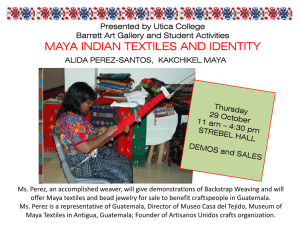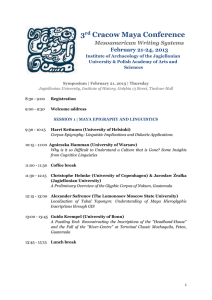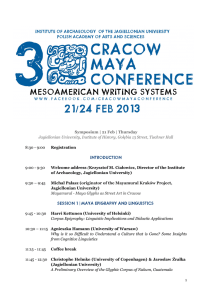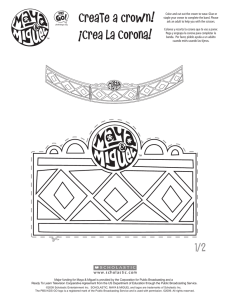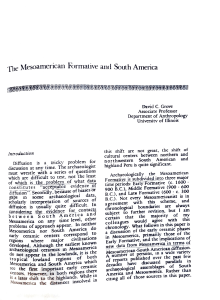The Hall of Mexico and Central America
Anuncio
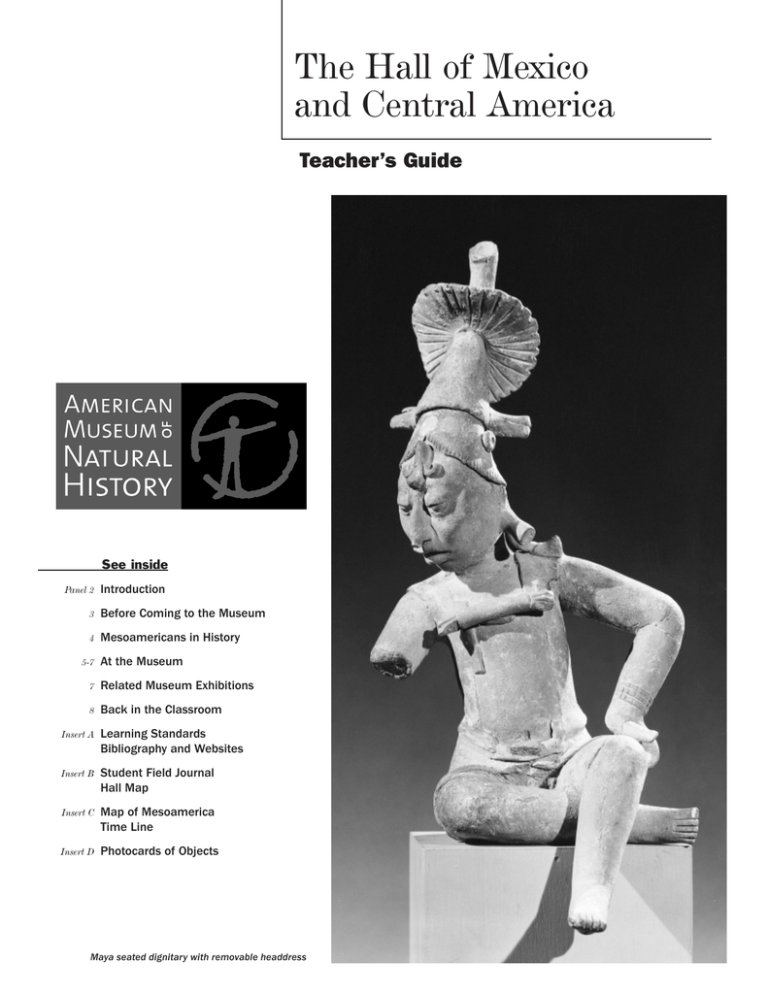
The Hall of Mexico and Central America Teacher’s Guide See inside Panel 2Introduction 3 4 Before Coming to the Museum Mesoamericans in History 5-7 At the Museum 7 Related 8 Back Museum Exhibitions in the Classroom Insert A Learning Standards Bibliography and Websites Insert B Student Field Journal Hall Map Insert C Map of Mesoamerica Time Line Insert D Photocards of Objects Maya seated dignitary with removable headdress Introduction “ We saw so many cities and villages built in the water and other great towns on the dry land, and that straight and level causeway going toward Mexico, we were amazed…and some soldiers even asked whether the things that we saw were not a dream." Spanish conquistador Bernal Díaz describing the magnificent Aztec capital of Tenochtitlán. Based on The Conquest of New Spain by Bernal Díaz, Penguin Books. The Hall of Mexico and Central America displays an outstanding collection of Precolumbian objects. The Museum’s collection includes monuments, figurines, pottery, ornaments, and musical instruments that span from around 1200 B.C. to the early 1500s A.D. Careful observation of each object provides clues about political and religious symbols, social and cultural traits, and artistic styles characteristic of each cultural group. WHERE IS MESOAMERICA? Mesoamerica is a distinct cultural and geographic region that includes a major portion of Mexico, Guatemala, Belize, Honduras, and El Salvador. The geographic borders of Mesoamerica are not located like those of the states and countries of today. The boundaries are defined by a set of cultural traits that were shared by all the groups that lived there. The most important traits were: cultivation of corn; a sacred 260-day calendar; a calendar cycle of 52 years; pictorial manuscripts; pyramid structures or sacred “pyramid-mountains;” the sacred ballgame with ball courts; ritual bloodletting; symbolic imagery associated with the power of the ruler; and temples, palaces, and houses built around plazas. The geography and landscape of Mesoamerica provided cultural groups with a variety of habitats in which to settle and develop. These include mountain and volcanic ranges, highland plateaus, lush rainforests, marshlands, and lowlands on the coasts of the Gulf of Mexico, Caribbean Sea, and Pacific Ocean. GREAT MESOAMERICAN CIVILIZATIONS The first groups of people in Mesoamerica were hunters and gatherers. Around 1500 B.C., they started building permanent settlements along coasts, rivers, lakes, and other water sources. Groups adapted to the surrounding environment by developing tools and domesticating plants and animals. As time passed, people started to settle inland and modify the natural landscape by building houses, plazas, temples, and water reservoirs. Many groups inhabited Mesoamerica, but the Olmec, Teotihuacan, Zapotec, Maya, and Aztec developed powerful civilizations that spread their influence throughout the region. All of them built great cities that had ceremonial, political, and commercial power. Their populations were dedicated to a variety of economic activities and societies were organized into specialized religious, military, and trade groups. Society centered around the ruler who was responsible for the welfare of the community and was usually the one in charge of performing special ceremonies to appease the gods. He also personified the sacred Tree of Life, which was thought to be planted in the center of the Earth and represented the three levels of the Universe: Heaven, Earth, and the Underworld. The elite, composed of the royal family, nobles, and highly educated artists, shared privileges with priests, prestigious warriors, and probably select merchants. The remainder of the population was dedicated to agriculture, construction, or trade, or labored in workshops, such as weaving, metalworking, pottery making, quarrying, stone carving, and featherworking. None of the civilizations of Mesoamerica existed in isolation. Trade flourished to supply specialty goods among different regions. By the 4th century A.D., there was a complex long distance network, trading regional specialties such as animal skins, shells, quetzal and other tropical bird feathers, flint, honey, and volcanic rocks like basalt and obsidian. Cacao beans and jade were especially valuable. Ceramics were also exchanged as market goods or royal gifts. Some populations and cities formed alliances while others engaged in warfare. Technology developed according to the resources that were available. It is important to note that these civilizations developed without the use of the wheel, metal tools, or animals of burden. Before Coming to the Museum FAMILIARIZE STUDENTS WITH THE FOLLOWING WORDS: Archaeology: The scientific recovery HAVE A CLASS DISCUSSION. Introduce students to themes that can be developed during your Museum visit. Use the following questions or develop your own. Encourage students to speculate and develop hypotheses about civilizations and the artifacts left behind. and study of objects from past cultures. 1. What do you know about the cultures of Mesoamerica? Ballgame: A sacred game, not a sport, in which 2. What do remains of buildings tell us about the organization of a civilization? players hit a ball (probably of rubber) with their torso, hips, and forearms. It was played during special occasions. The Maya word for ballgame was “pitz” and for ballplayer “Ah Pitzlawal.” For the Aztecs (in Nahuatl language) ballgame is “tlachtli.” Basalt: A hard volcanic stone commonly used in sculpture; its color varies from gray to black. Context: The place where objects and buildings are found, and their relationship with each other and their surroundings. The context gives a complete picture of the function of an object by providing clues to its use and meaning. Glyphs: ­Picture symbols that can be read as words, sounds, ideas, or numbers. The Maya painted them in ceramics and books, or carved them in stone. Indigenous: Native or natural to a place. The Zapotecs and Maya are two of the many indigenous peoples in Central America. Limestone: A white sedimentary stone from which the Maya cut slabs and blocks to build stelae and pyramids. It is obtained in quarries and, when first cut, is soft enough to carve easily. It hardens when weathered. Mestizo: A population of mixed European and Native American descent. Nahuatl: Language spoken by the Aztecs and still spoken today by some groups of Central Highland Mexico. Avocado (aguacatl) and tomato (tomatl) are Nahuatl words. Native Americans: All indigenous peoples that live in South, Central, and North America. Obsidian: Natural glass formed by the quick cooling of molten lava. Obsidian is usually black (with some examples in green) and was flaked and shaped into weapons and tools with extremely sharp edges. Axes and blades were made from obsidian. Precolumbian: The period of time before the arrival of Christopher Columbus to the New World in 1492. Stela (plural stelae): A stone slab carved to depict a ruler with a text written in glyphs. The Maya placed stelae in plazas and other public spaces to commemorate historical events. 3. How do civilizations demonstrate their power? PRACTICE THE SKILL OF OBSERVATION AND DEEPEN STUDENT UNDERSTANDING OF THE ARCHAEOLOGICAL PROCESS. Archaeologists study the history of past cultures by examining artifacts, building remains, and other natural specimens such as seeds, pollen, and bones. They record in detail an object’s location, shape, and material. The context of an object is very important in establishing its meaning. 1. Have students closely inspect the contents of a trash can that you provide. What do they find? Can they arrange the trash in chronological order? Can they classify the objects? What behaviors can be inferred from the items? Whose garbage might it be? 2. Observe an everyday object in class. Let the students examine it. How is it made? How is it used? Where is it normally placed or stored? Is it related to any other object or person in the class? Have each student make a sketch or write a description of the object. 3. Look at the photo-cards of objects from the exhibition. Have each student select one object for careful examination. Discuss why they selected their photo-card. Before reading the description on the back of each photo-card, have students describe the object in detail. Ask them to focus on the defining characteristics of each object. What else do they want to know about the object that the photograph does not provide? STUDY MAPS OF MESOAMERICA. The enclosed map is provided to give students a sense of Mesoamerica as both a physical and cultural place. In addition to this map, consider collecting other maps, travel brochures, and magazine photographs to complement your discussion of Mesoamerican geography and culture. Relate what you find in the photographs to places on the maps. •Mesoamerica encompasses more than one country. Which countries are part of this geographic region? •Create a trade route from the city of Teotihuacán to the Maya city of Tikal by using the shortest route and considering land and water ways. How do you think the merchants carried their goods? •Create a trade route for transporting basalt boulders from their source to San Lorenzo and La Venta. •Decide how to carry jade from its source to Palenque and Tikal. Mesoamericans in History Three terms— Preclassic, Classic, and Postclassic— are used by archaeologists to organize Mesoamerican history. PRECLASSIC PERIOD The Olmec built mounds and monuments in the swampy lowlands of southern Veracruz, Mexico, along the Gulf of Mexico around 1200 B.C. They carved colossal stone heads and created ritual objects and jewelry in jade and other stones. One of the major symbols used by the Olmec was the jaguar, which was associated with the ruler and warriors. It was the representation of the most powerful creature in the natural and supernatural worlds. The jaguar image, like other Olmec symbols, spread across Mesoamerica and survived throughout the Precolumbian era. The Zapotec peoples of Oaxaca produced the earliest known examples of hieroglyphic writing in Mesoamerica. The first true Mesoamerican city was Monte Albán, the capital of Zapotec civilization between 500 B.C. and 700 A.D. By 100 B.C., Monte Albán had extended its control into several surrounding valleys, thus creating Mesoamerica’s first empire. CLASSIC PERIOD The cities of the Maya region and the city of Teotihuacán flourished later, during the Classic period (250 A.D.–910 A.D.). These were planned cities with monumental architecture, markets, irrigation systems, roads, and neighborhoods. Colorful murals decorated the interior and exterior of many buildings. City layouts represented the Universe, with the East and West as the most important directional points associated with the path of the Sun during the day. While the city of Teotihuacán flourished in the Valley of Mexico, the Maya built most of their powerful city-states in the rainforest and limestone lowlands of southern Mexico, Guatemala, Belize, and Honduras. Both groups had commercial contacts with one another. Some buildings and ceramics found in the Maya city of Tikal, for example, show the influence of Teotihuacán style even though they are separated by hundreds of miles. Cities grew over time, putting pressure on the surrounding environments and populations. Other cultural groups flourished during the Classic period in Oaxaca at Monte Albán, several sites in West Mexico, in the Yucatán Peninsula, and in the highlands and Pacific Coast of Guatemala. All of the Mesoamerican groups developed special techniques for the creation of pottery and woven textiles, the making of pigments, and the carving of stones, bone, and other materials. The Maya developed an advanced writing and calligraphic system, using glyphs. The Classic period gradually ended as a result of social and political conflicts (within and among the cities), overpopulation, and over-exploitation of the natural resources. By 900 A.D. there was a collapse of the political systems throughout Mesoamerica, which motivated the development of highly complex groups in other areas. POSTCLASSIC PERIOD Among the last Mesoamerican civilizations were the Aztecs, who dominated the Postclassic period (910 A.D.–early 1500s). In 1325, they founded the city of Tenochtitlán (now buried underneath Mexico City), which the Spanish conquerors described as being as magnificent as the greatest European cities. The Aztecs excelled in the arts of sculpture, featherwork, goldsmithing, mosaic work, painting, long distance trade, and water engineering. The writing system was different from that of the Maya. The Aztecs painted books and textiles with colorful picture-symbols that are read not as sounds but as images that represent ideas. By the 1400s the Aztecs and their neighbors had formed the Triple Alliance, and seized control of vast territories beyond their homeland in the Valley of Mexico. They collected tribute from every corner of Mesoamerica. By the time of the Spanish Conquest (1519), the Aztecs were the most important military and political power in Central Mexico. Around 1519, the Spanish Conquistador Hernán Cortés landed on the coast of Yucatán and Veracruz. This was the beginning of the destruction of the Aztec Empire and surviving Maya Kingdoms. Alarmed by the Spanish arrival, Moctezuma, the Aztec Emperor, sent messengers to distant cities. Cortés and his army, supported by native enemies of the Aztec, looted Tenochtitlán and massacred almost three-quarters of the city’s population. After the European conquest, almost nothing of the glory of these civilizations was left. Much of what we know about Mesoamerican prehistory comes from archaeology and the historical accounts written by the Spaniards and North Americans. Many Precolumbian practices survive today, however, in the customs and thoughts of indigenous and mestizo peoples. At The Museum Use the selection of objects along with the enclosed Hall Map to develop a Museum lesson. Topics that you might want to focus on are: •How do objects provide evidence of daily life and religious beliefs? •How does the range of objects and materials reflect the diversity of Mesoamerican cultures? Students can: •Sketch objects and develop questions about what they see. •Look for details, patterns, or shapes that they might want to incorporate into a mural or book project. •Look at three objects from three different cultures. Locate or sketch each one of them on the map of Mesoamerica that corresponds to the period when the object was produced. •Bring the photocards to the Museum and look at similar objects in the Hall. Olmec Head: This is a cast of a colossal head that portrays a person wearing a decorated helmet. This monument, which weighs more than ten tons, was sculpted by the Olmec, the first major Mesoamerican civilization. It is one of approximately fifty heads found along the gulf coast of Veracruz. Facial characteristics and emblems vary from one head to another, suggesting they probably were portraits of important dignitaries or rulers, and the helmet suggests they were ballplayers. This basalt stone was transported seventy-five miles to be carved. •What does this object suggest about the organization of Olmec civilization? Stone Sculptures: All Mesoamerican cultures carved human, animal, or mixed figures from stone in different sizes. Most of the large sculptures in the Hall are made from limestone or basalt. Some sculptures were placed in public spaces as monuments to important people, while others represent sacred and mythic figures, sometimes in the shape of altars or containers. While the use of these sculptures may never be known since they lack inscriptions and information about context, they can still be used to develop students’ powers of observation and description. •Choose any large sculpture in the Hall and look at it carefully. What details provide clues about what the sculpture might represent? Jade: Jade was the most precious material for all the Mesoamerican cultures. It was finely carved and polished into jewelry, ceremonial scepters, ear spools, nose decorations and other ritual objects. The dead were often buried with a jade bead inside their mouth. Jade was also valued because it was difficult to acquire. The color of choice among the Olmec was blue-green, while the Maya preferred an apple green variety. Green symbolized water, vegetation, and fertility as well as the color of the center of the World. The only known source of jade is in Eastern Guatemala, but the differences in color between the Olmec and Maya jade suggest the possibility of another source not yet discovered. •Compare the jade objects in the Olmec and Maya exhibition cases. What differences do you observe in the shape, size, color, and design of the objects? Jaguar Images: Jaguars were the most powerful creatures in both the natural and supernatural worlds. The combination of precious material and jaguar imagery charged the object with power. The Kunz Axe, one of the largest examples of carved jade found in Mesoamerica, is a human figure with a jaguar face holding a small ax in its hands. Another object with jaguar imagery is the necklace with jade beads in the shape of jaguar fangs. •What are the characteristics of the jaguar that make it a symbol of power? Are there animals in our culture or any other culture you’ve studied which symbolize power? •Why do you think they combined jaguar and human features? Tomb 104 at Monte Albán, Oaxaca (reconstruction): This tomb is typical of an elite Zapotec burial. Above the door is a funerary urn, probably representing an ancestor of the deceased. Inside the tomb, the walls are painted with figures enacting a funerary procession and bringing offerings. Offerings of food and other valuable objects were placed in tombs throughout Mesoamerica. The body was surrounded by pottery and a set of small funerary urns decorated with human images. They were created by joining mold-made or hand-modeled pieces. Some were also painted. Urns were used in tombs and as dedication offerings during the construction of buildings. •How can a tomb tell us about the Mesoamerican ideas of the afterlife? •Examine the urns displayed in the case on the side. Scholars think many of the Zapotec urns represented ancestors. If you were living in Monte Albán, which urn would you choose for your ancestor’s burial chamber? Why? Teotihuacán Murals: Brightly painted stucco murals covered the insides of temples, palaces, and rooms at Teotihuacán. Most of the images show scenes of warfare, deities, and sacrifice. Others show images of the natural world, such as birds and flowers. The larger fragment depicts a man carrying a bag with incense and pouring water or other liquid as an offering, represented by the water lilies. The scroll coming out of his mouth indicates speech. This speech scroll was also used by the Aztec and other groups. The smaller mural fragment depicts flowers, probably water lilies, which represent water, life, and fertility. •Why do you think painted murals are an effective way to communicate? •What do you think the rest of the mural might have looked like? Aztec Sun Stone: This is a cast of a monument dedicated to the Aztec sun deity, Tonatiuh, seen in the center with his tongue thrust forward. Although not a functioning calendar, it records the signs of the twenty days. The four panels around the god’s face represent four previous creations or Suns. According to the Aztec calendar, we are now living in the Fifth Sun. During the Conquest, the Spaniards destroyed native cities, smashed altars and shrines, and constructed new buildings over them. This monument was discovered underneath the Cathedral in Mexico City and has become a symbol of Mexico’s heritage and nationalism. •Where do you think the sun stone was located in the Aztec capital of Tenochtitlán? •Why do you think it was important? •Why do you think it was found under the Cathedral? Maya Jaina Figures: Clay figurines were hand-modeled in different human and animal shapes, or pressed into molds to make hollow figures that were also used as whistles and rattles. The hand-modeled figures from the Island of Jaina, in the Gulf of Mexico, are considered some of the finest ceramic sculptures in the New World. They are found by the thousands as burial offerings. The human figures reveal details of Maya daily life including social status, gender roles, and fashion. •Look at the figurines and describe your favorite one. What features can you recognize and identify? •Tell a story about the character based on the details you observe. Maya Stela H of Copan: This cast represents the Ruler Waxaklahun Ubah–K’awil of Copan (known as “18 Rabbit”), one of the most powerful Maya rulers. During his reign he built beautiful palaces, plazas, and monuments, including the largest Maya stairway carved with glyphs. Although he was captured and decapitated by the ruler of the city of Quiriguá during a war, his successors always remembered him and included his name in their own monuments. He appears here dressed as the Corn God, a central character in Maya creation. He is crowned with a headdress made of long green quetzal bird feathers and possibly other materials, such as palm. The top of the headdress shows an ear and leaves of the corn plant. He also wears a net skirt made with round and tube-shaped jade beads; an underskirt of jaguar skin, symbolizing his power; and a royal scepter in the shape of a serpent, symbolizing the sky. •Compare this stela to the Olmec colossal head. •Compare this sculpture of an important ruler with modern monuments of people you have seen. What are the similarities and differences? The Ballgame: The ballgame was a sacred game played in open ballcourts with slanted ball player walls, or in front of the pyramids’ stairs throughout Mesoamerica. For the Mesoamericans, the ballgame ritual reenacted a mythical game played between humans and supernatural beings; but at the time of the Spanish Conquest, it was a game both for divination and amusement. Sacrifice could also take place at the end of the game. The rules of the game, the number of players on each team, and the size of the rubber ball are still unknown. Paintings in murals and ceramics depict players hitting the ball with their torsos, forearms, knees, and elbows. The game required the use of protective gear such as elbow and knee pads made of thick fibers, cloth, or leather. Horse-shoe shaped yokes were also wrapped around the waist to protect the chest and groin. These yokes were made of the same materials as the other gear, although the only surviving examples are carved in stone, probably as commemorative objects. •Look at the ceramic figurines next to the ballgame model. What parts of the protective gear can you recognize? Painted Pottery: Ceramics were made of clay and painted with colors based on mineral pigments. Surface decoration depended on the cultural group, techniques used, and style of the time. Most vessels were painted before firing which makes the color permanent and allows the vessels to be washed. Throughout the gallery there are many examples of painted pottery for daily use as well as for ritual offerings. The finest objects were used only by the elite. These ceramics were important objects of trade and were exchanged as royal gifts. Maya painted pottery are the only ones that include kings, gods, and glyphs. •Look at the painted pottery in the various sections of the gallery. What colors are the most common? •Select a pot and draw one of the designs that interests you. Related Museum Exhibitions Gottesman Hall of Planet Earth 1st floor See samples of some of the raw materials used by Mesoamerican civilizations in this Hall. Students can observe and touch pieces of obsidian, limestone, and several types of basalt. Consider asking these questions: Which kind of rock would you choose to make a tool or weapon? Which rock seems easy to carve? Harry Frank Guggenheim Hall of Minerals Morgan Memorial Hall of Gems 1st floor Watch the film Forever Gold. Learn about the history of gold and its importance to early civilizations. Hear how the discovery of gold by European explorers led to the destruction of the Inka and Aztec cultures. Visit the sample of nephrite jade at the entrance to the Hall of Gems. Examine the beautiful jade vases, goddesses, and other objects from different cultures. Hall of South American Peoples 2nd floor Visit the Sipán Tomb Excavation near the entrance to this Hall. What do you think archaeologists can learn about this culture's way of life by examining the placement of the individuals and objects in the tomb? Go inside the Hall and examine the ceramics, textiles, and metalwork of the civilizations of South America. What similarities and differences do you see in the use of these materials in the civilizations of Mesoamerica and South America? Back in the Classroom We suggest that after visiting the Museum, you extend the experience through the next several weeks. For additional information regarding educational programs, please contact: American Museum of Natural History Department of Education Central Park West at 79th Street New York, NY 10024-5192 This Teacher’s Guide is supported by a grant from the Louis and Virginia Clemente Foundation, Inc. This guide was produced by the American Museum of Natural History, Department of Education. WRITERS: Sofia Paredes-Maury, Stephanie Fins, Heather Nielsen ILLUSTRATIONS: Sofia Paredes-Maury HALL MAP: Choonyong Lee MAP OF MESOAMERICA: Joyce Pendola MATERIALS REVIEWED BY: Charles Spencer, Curator of Mexican and Central American Archaeology; and Thomas Cuddy and Christina Elson, Scientific Assistants. PHOTOGRAPHS: ©American Museum of Natural History DESIGN: Davidson Design, Inc. New York, NY © American Museum of Natural History 1999 Printed in the United States of America 1. Use Museum observations and student derived questions as the seed for a research paper on Mesoamerica. Do research using books from the bibliography, the library, and from Internet sources. What questions did the Museum visit raise about the organization of Mesoamerican civilizations? Ask students to consider the difference between analyzing visual materials at museums and from texts at school. 2. Think about the objects you have seen at the Museum that commemorated lives of individuals—such as the Olmec head, stela H from Copan, Tomb 104, and the Maya Jaina figures. Using clay and other materials such as feathers, string, beads and leather, have students create a portrait of an individual. It can be someone important to them or a historical figure. After the portrait is complete, have students share with the class, indicating what attributes they have captured and why they selected that individual. 3. Have your class create a mural that portrays aspects of daily life or a historical event. Create a set of symbols that can be easily interpreted by other viewers. 4. Stone figures, clay pots, jade ornaments, and painted murals are the visual records of Mesoamerica’s politics, economics, beliefs, and history. What objects or images from the present or past would students select to represent their culture? Why do their choices of objects and images serve as valid representations of their life? 5. Mesoamerican civilizations are portrayed in a variety of ways in the mass media. Have your class collect examples from magazines, newspapers, travel brochures, books, and websites. Have students look critically at the collection of images. Evaluate the way Mesoamerica is portrayed in the media and compare it to what they learned during your Museum visit and research in the classroom. Discuss the architecture, environment, and characteristics of the buildings as shown in the photographs. Which images of sites and artifacts appear most frequently? Why do you think that is? How are these images being used to communicate information about Mexico and Central America? Learning Standards The Hall of Mexico and Central America offers teaching and learning opportunities that support standards-based curriculum studies in social studies and the arts. The pre-and post-visit activities were designed with these standards in mind. NYS LEARNING STANDARDS FOR SOCIAL STUDIES STANDARD 2: World History The study of world history requires an understanding of world cultures and civilizations, including an analysis of important ideas, social and cultural values, beliefs, and traditions. As a result, students: •know some important historic events and developments of past civilizations. •interpret documents and artifacts related to developments and events in world history. The study of world history establishes time frames, explores different periods, examines themes across time and within cultures, and focuses on important turning points. As a result, students: •develop timelines highlighting important events. •measure time periods by years, decades, centuries, and millenia. STANDARD 3: Geography Geography is divided into different elements which can be used to analyze important historic, geographic, economic, and environmental questions and issues. Students: •map information about people, places, and environments. •investigate and describe the connections and relationships between people and places. NYS LEARNING STANDARDS FOR THE ARTS STANDARD 3: Responding and Analyzing Works of Art Critical response to works of art connects the individual work to other works and other aspects of human endeavor and thought. Students: •describe what they see in a work of art and tell what they think the work of art is about. •explain their reflections about the meanings, purposes, and sources of works of art. STANDARD 4: Understanding the Cultural Dimensions and Contributions of the Arts Exploration of art and artifacts from various historical periods and world cultures helps students discover the role that art plays in the lives of people of a given time and place. Students: •research and demonstrate how artifacts from diverse cultures reflect rituals and beliefs. •demonstrate the ways in which some artifacts reflect important aspects of the diverse cultures of the United States. Department of Education The Hall of Mexico and Central America BIBLIOGRAPHY AND WEBSITES Resources for Teachers: Boone, Elizabeth. 1994. The Aztec World. (Jeremy Sabloff, editor) Montreal and Washington, DC: St. Remy Press and Smithsonian Institution Books. Coe, Michael D. 1994. Mexico: From the Olmecs to the Aztecs. Fourth Edition. London: Thames and Hudson Ltd. Culbert, Patrick. 1993. Maya Civilization. (Jeremy Sabloff, editor). Montreal & Washington, DC: St. Remy Press and Smithsonian Institution Books. Miller, Mary Ellen. 1996. The Art of Mesoamerica: From Olmec to Aztec. London: Thames and Hudson Ltd. Townsend, Richard. 1993. The Aztecs. London: Thames and Hudson Ltd. Resources for Children: Gerson, Mary-Joan and Carla Golembe. 1995. People of Corn: A Mayan Story. Boston: Little, Brown and Company. Libura, Krystyna; Burr, Claudia; and Urrutia, Maria Cristina. 1997. What the Aztecs Told Me. Ontario: Groundwood Books/ Douglas & McIntyre. MacDonald, Fiona. 1998. Step into the Aztec and Maya Worlds. New York: Lorenz Books. Steele, Philip. 1997. Aztec-News: The Greatest Newspaper in Civilization. Cambridge: Candlewick Press. Websites: http://anthro.amnh.org/ Department of Anthropology, American Museum of Natural History www.famsi.org Foundation for the Advancement of Mesoamerican Studies www.archaeology.org Archaeology Magazine, Archaeological Association of America http://copan.bioz.unibas.ch/mesolinks.html Pre-Columbian Archaeology Related Links Department of Education P A C I F I C A t o y ac O C E A N LA VENTA (Olmec) Tuxtla Mountains Guatemala City ag u a COPAN (Maya) Tegucigalpa San Salvador E L S A LVA D O R M ot C HONDURAS BELIZE Belmopan QUIRIQÚA G U A T E M A L A (Maya) TIKAL (Maya) ISLA DE JAINA (Maya) CHICHEN ITZÁ (Toltec/Maya) Motagua River Valley PALENQUE (Maya) Us M E X I C O ta 100 miles TRES ZAPOTES (Olmec) O F SAN LORENZO (Olmec) G U L F Altotonga MONTE ALBÁN (Zapotec) M E X I C O Orizaba Otumba TEOTIUHUACÁN (Teotihuacan) Mexico City Bal sas TENOCHTITLÁN (Aztec) Pachuca KEY Modern City Mesoamerican site Obsidian source Basalt source Jade source S E A I B B E A N R A um in ac 1200 BC Kunz Axe Olmec Head Height of Olmec Olmec 900 BC 600 BC 300 BC PRECLASSIC Department of Education 0 450 AD Zapotec Tomb 104 at Monte Albán, Oaxaca 600 AD Maya Stela H of Copan 750 AD Maya Jaina figures Height of Teotihuacán Teotihuacán murals Teotihuacán Maya Urban centers in Maya region Height of Zapotec 250 AD CLASSIC 900 AD Chichen Itzá Toltec Toltec-Maya 1200 AD Founding of Tenochtitlán 1521 AD Conquest of Aztec Empire Aztec sun stone Columbus arrival to New World Aztec Mixtec 1492 AD POSTCLASSIC Keep this original. Duplicate and cut the photo cards in sufficient quantities so that each student gets one card. These objects or similar ones are represented in the Hall. WHEELED DEER Even though the wheel was not used in Mesoamerica for practical purposes, small ceramic figures with wheels have been recovered from many sites. This figure, found in Veracruz, was probably a toy. State of Veracruz, Mexico Classic Period AD250 – AD900 Cat. # 30.2/9734 VILLAGE MODEL Unique model that shows a group of houses around a “Sacred Tree”, thought to be located in the center of the World and connecting Sky, Earth, and Underworld. Twenty-two human figures and a dog point to the branches where thirty-two different kinds of birds are posed. Found in Colima, but probably made in Nayarit. Late Pre-Classic Period 400BC– AD200 Cat. #30.3/2461 BALL PLAYER This clay figurine depicts a ballplayer wearing a protective yoke around his waist. Yokes were made of stone, but they could also be molds to make leather yokes. This figurine has its body decorated with tattoos and other signs of beauty. State of Veracruz, Mexico Classic Period AD250–AD900 Cat. #30.3/1287 TEOTIHUACÁN FIGURINE This ornamented clay figurine is hollow and has a dismountable front. Inside, there are miniature figures of deities modeled in clay and carefully applied. The people of Teotihuacán believed in a mythical cave from which peoples originated. This figure probably represents the cave. Teotihuacán, Mexico Pre-Classic Period 200BC–AD400 Cat. # 30.1/9188 COLIMA DOG Dogs were important in Mesoamerica as pets and hunting companions. Figures of dogs in clay and stone were also placed in tombs to serve as companions in the voyage to the Underworld. In daily life, small, hairless dogs were also fattened to be consumed as food. State of Colima, Mexico Late Pre-Classic Period 400BC– AD200 Cat. #T149 HOUSE MODEL Clay model that has a pyramid base and a conical, probably thatched, roof. Human figures interact with animals and are engaged in daily chores. Clay models were placed inside tombs and provide clues to the shape, spaces, and design of buildings. State of Nayarit, Mexico Late Pre-Classic Period 400BC–AD200 Cat. #30.3/2458 DWARF FIGURINE Dwarfs were considered special characters in Mesoamerica because they were associated with the gods. Figurines, painted ceramics, and carved monuments show dwarfs in fancy attire and engaged in important activities such as assistants to the ruler. The image of this figure wears pendants, earspools, and bracelets. Maya Culture (Mexico and Guatemala) Late Classic Period AD600–AD900 Cat. # 30.3/1029 AZTEC DRUM The peoples of Mesoamerica played different musical instruments such as whistles, flutes, shell trumpets, and drums. The Aztecs had two kinds of drums, and this one is a teponaztli, a horizontal wooden cylinder made from a hollowed-out log. Each slit on the top produces a slightly different sound. Aztec Style Post Classic Period AD1400 – AD1600 Cat. #30.2/9671 Stela A Copan Stela H Copan Mixtec Costa Rican and Panamanian Gold Costa Rica and Panama Toltec Huasteca Aztec Sun Stone Costa Rican Stone Sculpture Maya Pottery Jade Aztec Aztec Musical Instruments Maya Stela F Quirigua Temple Models Maya Ceramic Sculpture Temple Models Maya Stela E Quirigua The Maya The Hall of Mexico and Central America Vera Cruz Toltec Xipe Totec Huastec Stone Sculpture Tomb 104 Monte Albán Oaxaca Oaxaca Veracruz Stone Sculpture Model Ball Court Teotihuacán Oaxaca Urns Teotihuacán Olmec Jade Western Mexico Colima Western Mexico Mexico and Central America: Introduction Olmec Guerrero Western Mexico Nayarit Jalisco Central Mexico Department of Education Pre-Classic Tarascan Stone Sculpture Olmec Colossal Head
